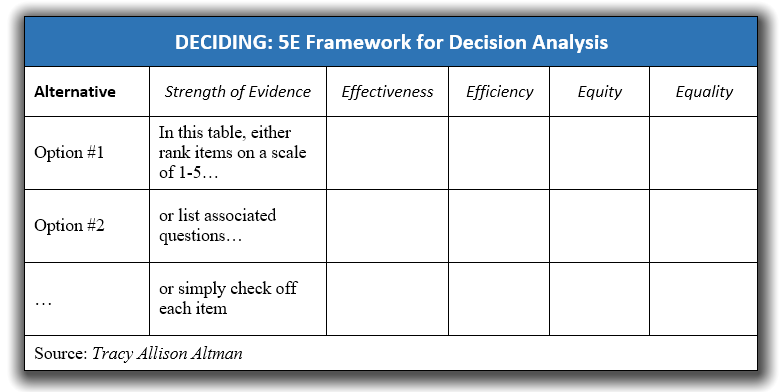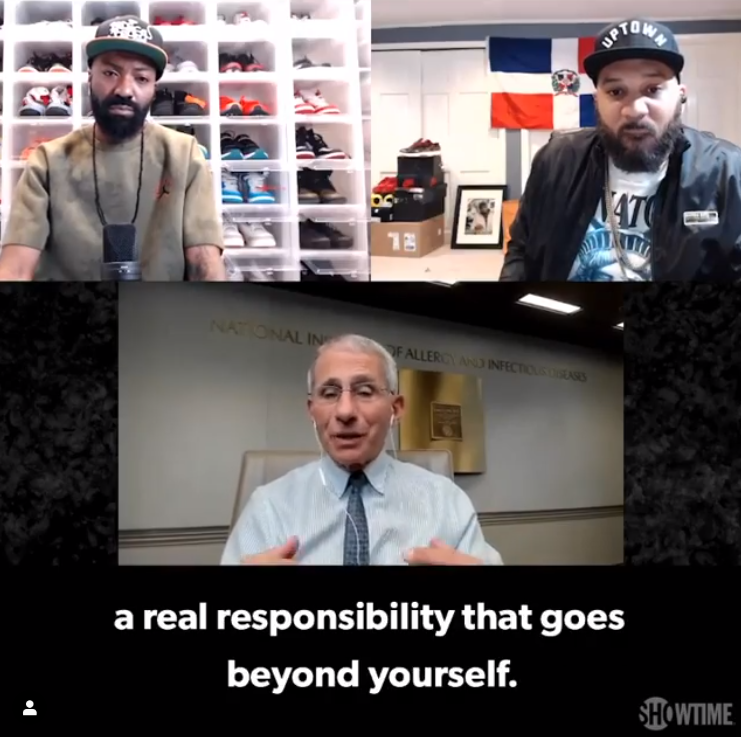This is an anxious time for anyone in policy / decision analysis. Machine learning, analytics, statistical models, and decision intelligence are helping leaders grapple with the coronavirus pandemic, but weighing alternatives and connecting actions → outcomes requires so many things.
Once the modeling is complete and the data visualizations are shared, then what? Newly anointed health hero Dr. Anthony Fauci explained the challenge on Desus and Mero.* Given a relentless stream of information, he must “consume it, integrate it, and make policy of it.” Andrew Cuomo is in the same boat.

Integrate data with the decision in mind.
Right now, it seems the ‘shutdown’ choice is a given, and only a heartless fool would question it. But alternative responses have been floated, not all by wackadoodles.**
What is the best way to weigh costs/benefits of a possible action, and whether it reflects desired values? Simply put, deciding requires us to identify and rank options, then choose one.
During my PhD studies in public policy analysis, we considered complex decisions where paint-by-numbers would never work. I learned a practical method well-suited to exploratory analysis or high-level final review. While I’m thinking today about public health, the 5E framework works for business decisions, too.
The 5Es: Evidence, effectiveness, efficiency, equity, and equality.
Analyze the hard decisions from five perspectives: Evidence, effectiveness, efficiency, equity, and equality.*** (I’ve also added Eyeballs, as explained later.)
1. Strength of Evidence. Decision makers must determine if the available data are on point. Are the findings believable? How will conflicts be resolved? Example: Statistical models differ when predicting the peak of the pandemic in key geographies.
2. Effectiveness. What is the predicted efficacy of the intervention (performance in ideal conditions)? How effectively can objectives be achieved in the wild? How are risks quantified? Keep in mind what you’re trying to do. Example: To flatten the curve, are interventions intended to delay the date people get infected, or avoid coronavirus infection entirely (or both)? Holman Jenkins Jr. discussed this in the Wall Street Journal.


Keep it simple. It’s unrealistic to expect a single app to synthesize all this, but a high-level summary is essential. Here’s a table format you can use to show how well each alternative satisfies the 5Es. Check off items, or score (on a scale of 1-5) the degree to which each option meets objectives. Of course, what lies beneath is a ton of analysis.
3. Efficiency. How well does each alternative maximize the use of available resources? How much unproductive disruption will result? Example: How much economic devastation and mental health impact can we afford? To justify X billions of dollars in lost economic output, how many lives must be saved? It sounds harsh, but somebody has to stare down that question.
4. Equity. Does the preferred option encourage social justice? Who are the winners and losers? Will some people be disproportionately affected? Example: Shelter-at-home orders have drastically different consequences for bus drivers and hair stylists vs. video game designers and writers.
5. Equality. Does the preferred alternative treat people equally, and should it? This one gets tricky, because sometimes equality is the last thing you should be pursuing. Example: Providing financial relief of $1,200 to working-class people, or providing the cash to every US citizen, including the rich.
6. I suggest adding Eyeballs to your analysis. You don’t know what you don’t know, so showing your ideas to others is a useful (sometimes humbling) experience. No matter how representative your cross-functional/inclusive team is, few plans survive first contact with the enemy. Avoid disaster with early participation from your target community, organization, or population. Tread lightly when hair-on-fire problems are at stake: Blowback (internal or external) may be inevitable. But you can get out in front of objections with a transparent explanation of your chosen action, warts and all.
Seriously, a seventh E? Adopting this framework adds much-needed empathy to the equation.
~Let me know what you think. Is the US using the best process to make public health decisions?
__________________________
* On Showtime. I love D&M, but viewer satisfaction is not guaranteed.
** Paul Romer (Nobel laureate) and Alan Garber (economist, physician, Harvard Provost) argue that the US should spend upwards of $100B on protective gear and widespread tests, allowing most of us to continue our regular activities and avoiding this shutdown. They claim this alternative would avoid a depression while saving lives. Read/listen at New York Times Op-Ed, NPR Planet Money, or Marketplace. I’m unclear whether the Romer/Garber proposal has gotten traction, but who is to say they’re wrong?
Meanwhile, Arkansas Governor Asa Hutchinson favors mask wearing and social distancing, but without a shutdown. Problem is, there’s not enough spending on testing protective gear.
And in the US, Major League baseball has proposed a similar idea: Isolating players in hotels and opening the season with games in empty stadiums. I would gladly grab a Coors Banquet and tune in.


*** There are variations on this theme. For instance, some evaluate 3 Es (effectiveness, efficiency and equity) when conducting impact assessment” [Nature, 2016]. See also a 4E framework: Public policy values of economy, efficiency, effectiveness, and social equity [Journal of Public Administration Education, 2011].
Posted by Tracy Allison Altman on 8 April 2020.








